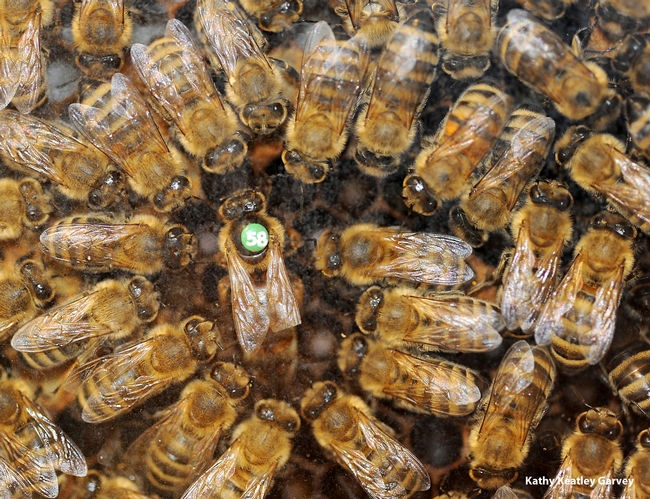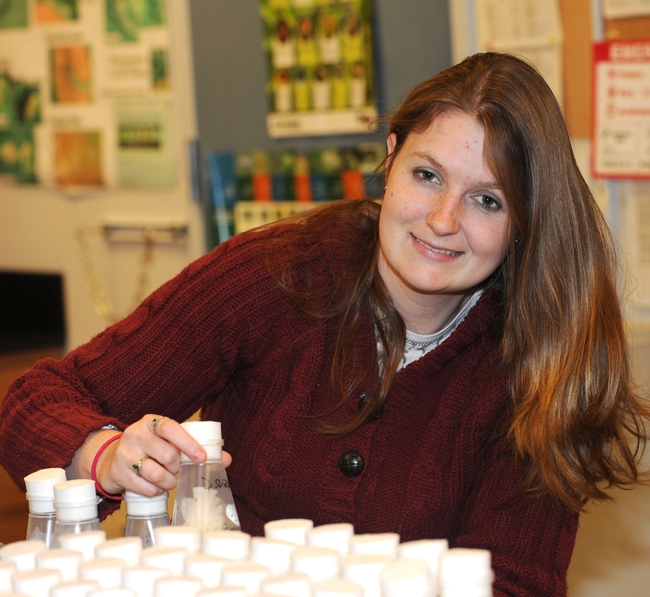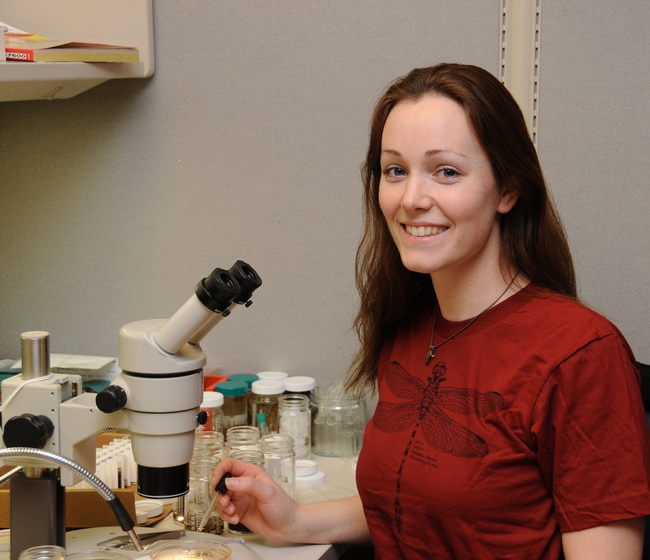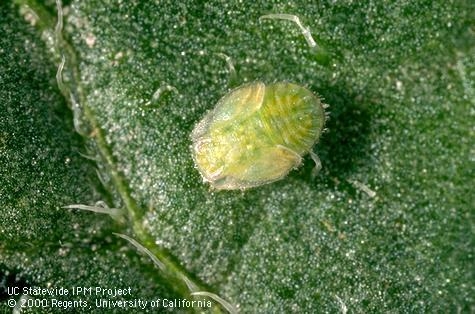UC Blogs
Those 'Immoral' Honey Bee Queens
The news headlines screamed "immoral" and "promiscuous." The story was not about a red light district or "Ladies of the Night" or even linked to...

Queen and her court. (Photo by Kathy Keatley Garvey)
Nitrate report covered extensively in news media
A report released March 13 by UC Davis, "Addressing Nitrate in California Drinking Water," is being covered by a wide variety of media outlets. Following are links to the stories:
Drinking water risk in the Central Valley
KGET - TV, Bakersfield
Canella statement on report about nitrates in drinking water
Sen. Anthony Canella, The Merced Sun-Star
Project assesses management of nitrate on farms
Kate Campbell, AgAlert
UC nitrate report prompts calls for action
Central Valley Business Times
Nitrate pollution beginning to affect Salinas water quality
Larry Parsons, The Monterey County Herald
Nitrates in California drinking water, study finds
Peter Fimrite, San Francisco Chronicle
Groundwater nitate contamination grows in California farm areas
Bettina Boxall, The Los Angeles Times
Study: Drinking water at risk from California agriculture
Donna Jones, The San Jose Mercury News
Widespread nitrate contamination reported
United Press International
UC study: Cropland threatens drinking water for 250,000 in Valley
Mark Grossi, The Fresno Bee
(Also in the Sacramento Bee and Modesto Bee)
Report: Calif. nitrate contamination spreading
Gosia Wozniacka, Associated Press
Study Cites Risk For Farm Belt Drinking Water
Sasha Kocha, The California Report
Viewpoints: Risks, costs will rise from contamination of drinking water
Thomas Harter and Jay Lund, UC Davis, The Sacramento Bee
(Also in the Modesto Bee)
Farming communities facing crisis over nitrate pollution, study says
Stett Holbrook, Food & Environment Reporting Network, MSNBC
Report: Nitrate from Fertilizer Polluting Drinking Water in Ag Regions
Lon Abbott, Public News Service
My Heirloom Garden
Heir·loom \’er-,lÜm\: 1: a piece of property that descends to the heir as an inseparable part of an inheritance of real property 2: something of special value handed on from one generation to another. 3: a horticultural variety that has survived for several generations usually due to the efforts of private individuals.
My dad, Bob, passed away about 2 years ago, and I always think about him this time of year especially, since it would’ve been his birthday last week, and I undoubtedly would’ve brought him some home-baked cookies and a plant or garden tool. Every spring, when I was younger we’d go to a garden shop and buy a pansy or petunia for me to take home and keep in my windowsill. Since I didn’t live with him, I think it was his way of saying he’s always around.
Every time I went to my dad’s house something new seemed to be sprouting or growing. He was especially good with roses. Always telling me that they’ll grow if I’d just stick ‘em in the ground. One day I’d go to visit and he’d have them all pruned back and I’d think how in the world will they ever come back?
But, sure enough, next visit there they’d be with buds, and the next visit with big full blooms smelling wonderful with that old-fashioned rose scent. I’d often comment on my way to the car, and sooner than I could turn around, he’d have a few buds snipped with the stems wrapped in a moist paper towel so they’d stay fresh until I got home.
In another shady corner next to his shed were violets (Viola odorata), that were just prolific! Their tiny purple blooms fill the air with a light scent that you would imagine in a fairyland somewhere. Eventually, they spread to be under some of the rose bushes along with a bit of fern. What a treat for the senses that always was!
And every early spring, I’d always forget that there were daffodils. Since we usually entered in his back door I would never notice them until I would decide to take my “walk around” to see what was happening in his yard. I’d walk out to the front porch and practically staring me in the face would be the tallest daffodils! Mind you his porch was about 2 ½ feet high off the ground! Those would have to be the strongest bulbs I’d ever see, since they really had to reach to get some of the sun. I think he planted them for his wife, Harriet, who had loved the color yellow.
We finally sold his house last year as much as we wanted to keep it, it was in a senior living area and we weren’t allowed to rent it out. My husband waited patiently on the last moving day as I “walked around” one more time breathing in each scent and trying to remember it forever.
Just last week, I was doing a “walk around” of my own house, when I noticed something growing in a bin. It was my dad’s “compost” bin. Just an old 15 gallon black planter’s tub that he used to throw his clippings in after pruning. I guess I’d forgotten. I’d dug up some of those daffodil bulbs and tossed them in hoping that I’d be able to get the same spectacular results that he had gained. But alas, I never planted them. Disappointed and figuring that they turned to compost themselves after a year of sitting, I passed by the tub day after day never having the heart to recycle it and had decided to use it for my own trimmings. What a surprise! Those bulbs had grown and bloomed in his bin and there they were! Rejoice! Two perfect daffodils (I think one for Dad and one for Harriet), right in the bin, right at my house, just like he was saying again that he’d always be around.

My Dad's Daffodils March 2012. (photo by Patti Brantley)
Post Here, Please
It promises to be both exciting and informative.Some 200 freshmen at the University of California, Davis will present their research posters on...

Kelly Hamby, seeking her doctorate in entomology from UC Davis, works on spotted wing drosophila research in the Frank Zalom lab. (Photo by Kathy Keatley Garvey)

Danielle Wishon, an undergraduate student in entomology at UC Davis, works at the Bohart Museum of Entomology. (Photo by Kathy Keatley Garvey)
Washington Post reports on 2012 pest surge
This winter's eerily warm weather might soon get creepy, reported Darryl Fears in the Washington Post. The Orkin pest control company said its agents nationwide are getting a 30 percent increase in calls to treat ant infestations, compared with this time last year.
For farmers, pesticide costs might get expensive. Aphids and psyllids, also called place lice, are among the pests that plague farmers. Eric Natwick, a UC Cooperative Extension advisor in Imperial County, told the reporter that aphids are a big problem because, when feeding, they can transmit a pathogen that destroys vegetables. Natwick is an entomology expert.
Tomato psyllids — lightning fast and tremendous jumpers, for their size — are also showing up this year in California’s Imperial Valley. The psyllids tend to infest produce in California’s Coachella Valley, across a desert from the Imperial, but “when I see them here, it’s unusual,” he said.

Tomato psyllid nymph showing flattened, scalelike appearance.


